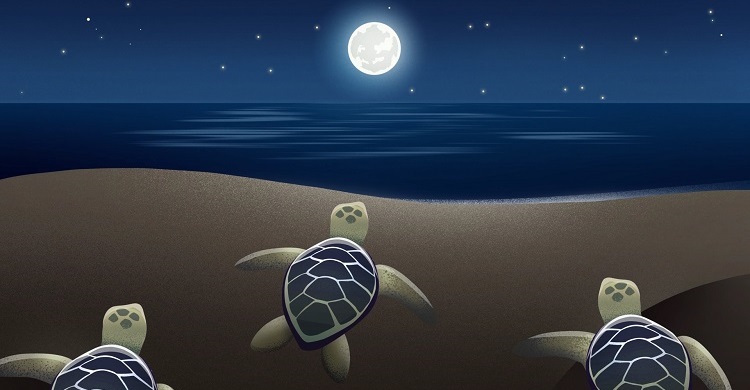Light Pollution – there is a Solution!

Hatchlings crawling towards moonlight © Australian Government
By Karen Arthur, Caesar San Miguel, Narelle Montgomery
Department of Agriculture, Water and the Environment
Government of Australia
Light pollution refers to artificial light that alters the natural patterns of light and dark in ecosystems. It is best known for its negative impacts on marine turtles, deterring adults from nesting and disorienting hatchlings so they waste energy finding the water, or worse, die trying. However, artificial light at night can have broader impacts on the environment and many of us do not realise how far reaching these effects can be. Artificial light is known to adversely affect many species and ecological communities by disrupting critical behaviours in wildlife and functional processes, stalling the recovery of threatened species, and interfering with a migratory species’ ability to undertake long-distance migrations integral to its life cycle, or by negatively influencing insects as a main prey of some migratory species. The far-reaching effects of light pollution have been recognised with World Migratory Bird Day 2022 adopting the theme of “Dim the Lights for Birds at Night”.
To address these conservation challenges, the Australian Government brought its Light Pollution Guidelines for Wildlife to the attention of the Signatory States of the IOSEA Marine Turtle MOU at the 8th Meeting of Signatories in 2019, where they were welcomed and recommended for use throughout the MOU area. Subsequently they were also endorsed at CMS COP13 through a resolution, which encouraged their promotion particularly through subsidiary Agreements. Though the guidelines provide general guidance that can be applied to all wildlife, they also have appendices that deal specifically with marine turtles, seabirds and migratory shorebirds.
The guidelines include technical information about light, how to measure it, best practice light design principles (Figure 1), taxa specific guidance and case studies. They also provide a framework for assessing and managing the impacts of artificial light on wildlife through a risk assessment and adaptive management built around a concept of best practice lighting design principles (Figure 2).
One of the main purposes of the guidelines is to raise awareness about the impact of artificial light on wildlife. To help with sharing information about light pollution and how to manage it, the Australian Government has also developed a series of short entertaining animations that explain what light pollution is and how it can be managed, including one focusing on marine turtles (check it out here).
Another important purpose of the light guidelines is to reduce landscape scale light pollution, or sky glow, for protected wildlife like marine turtles. Sky glow is particularly challenging as it is generally the result of multiple light sources and means that consideration must be given to all sources of lighting that are visible outside.
Figure 1 Six Principles that are broadly applicable for managing light pollution.
The guidelines also provide a recommended environmental impact assessment (EIA) process for managing light impacts on wildlife (See Figure 2). Light management must be considered on a case-by-case basis since light impacts differ from species to species and lighting conditions are geographically dependent. Because of this, the guidelines cannot prescribe specific light levels and mitigations that will be safe for all wildlife. Instead, the success of light management is determined by whether wildlife can continue to engage in important behaviours.
Figure 2 Environmental Impact Assessment Process.
To help switch off light pollution you can:
- Take a look at the Light Pollution Guidelines for Wildlife. Share the information available on the CMS Webpage and the Australian Government on the Departmental light pollution webpage
- Consider what you can do personally to minimise artificial light.
Last updated on 24 May 2022







